Some Instruments of
Note

If you have ever been to a medieval or renaissance faire, you know
that they are sensory treats for patrons. I suppose that they have to
be, or else no one would go to them.
I have frequented a few, and I find them highly entertaining. My
belief is that they are best experienced in period garb even if I am
not a part of the cast. So, I tend to show up in peasant clothing,
carrying the accouterments of a scribe or some bardic
troubadour. I have taken the time to set up a scribe booth in the
past, but the amount of dust in the air at these events often makes
any meaningful scribe work a bit of a mess. Instruments, however,
don't suffer as much from a bit of dust on the wind.
Pictured above are the following instruments: Acoustic Bass
Guitar, Autoharp, Djembe (large and small), Mandolin, Octave
Mandolin, Guitar, Lap dulcimer, Tambourines (with cymbals and
without), Multi Tone Wood Block, Guiro, Clave, Rain Stick, Nose
Flute, Kalimba, and a Frog. These are the sorts of Instruments that I
have used on a
couple of CDs that I have produced.
Instruments:
 Autoharp:
This is a chromatically strung instrument with many strings covering
its face. There is a series of levers set over these strings with
felt dampeners on them that each stop certain strings from vibrating
when they are depressed. depressing a button and strumming the
strings produces predefined chords.
Autoharp:
This is a chromatically strung instrument with many strings covering
its face. There is a series of levers set over these strings with
felt dampeners on them that each stop certain strings from vibrating
when they are depressed. depressing a button and strumming the
strings produces predefined chords.
Bass Guitar: This is a hollow body bass
acoustic guitar. The low sound tends to round out the sound of some
pieces, and lends a slightly more modern aesthetic to some music.
 Clave:
These instruments are basically two hard wood sticks that are clicked
together. They produce a brief sound that is a particularly high note
for percussion.
Clave:
These instruments are basically two hard wood sticks that are clicked
together. They produce a brief sound that is a particularly high note
for percussion.
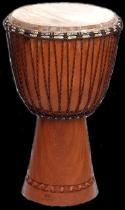 Djembe:
the djembe is an African drum similar to many other ethnic drums
around the world. The drum head is made from stretched goat hide
which produces a low note when struck in the center, and a higher
note when struck along the edge.
Djembe:
the djembe is an African drum similar to many other ethnic drums
around the world. The drum head is made from stretched goat hide
which produces a low note when struck in the center, and a higher
note when struck along the edge.
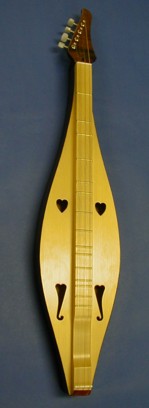 Dulcimer:
The lap dulcimer is generally only played on one melody string, with
two drones, sounding a bit like a stringed bagpipe. The drones can be
fretted as well, but since it has diatonic frets, there are some note
combinations that are just impossible. Medieval harmonies would most
likely sound primitive by our modern standards, and the droning sound
of a dulcimer is appropriate for a faire setting even if the sound of
metal strings may not be.
Dulcimer:
The lap dulcimer is generally only played on one melody string, with
two drones, sounding a bit like a stringed bagpipe. The drones can be
fretted as well, but since it has diatonic frets, there are some note
combinations that are just impossible. Medieval harmonies would most
likely sound primitive by our modern standards, and the droning sound
of a dulcimer is appropriate for a faire setting even if the sound of
metal strings may not be.
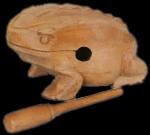 Frog:
This is a wood block with ridges. There is a stick that is run over
the ridges on the back to make a croaking noise - or you can just
whack it with a mallet for a simple block sound.
Frog:
This is a wood block with ridges. There is a stick that is run over
the ridges on the back to make a croaking noise - or you can just
whack it with a mallet for a simple block sound.
Guiro: This is a hollow gourd instrument
with ridges cut into one side. By running a stick or comb over the
ridged side, a rhythmic scraping sound is produced.
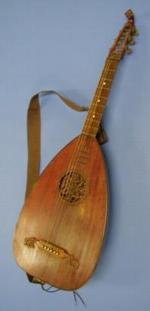 Guitar:
I purchased a lute style guitar on ebay. It is of a style that was
being made at the end of the 19th century. I was led to believe that
it is about a hundred years old, but I cannot prove it. This is not
really what musicians would have used during the renaissance or
earlier, but the average patron of such fairs would not know an
authentic instrument of the time if it stepped up and bit them. I
have had some major repair work done on it, including patching a hole
in the back, regluing the slats on the bowl, replacing some frets on
the body, and reattaching the rosette. With folk guitar strings, it
does have a nice sound to it. It is also quite light.
Guitar:
I purchased a lute style guitar on ebay. It is of a style that was
being made at the end of the 19th century. I was led to believe that
it is about a hundred years old, but I cannot prove it. This is not
really what musicians would have used during the renaissance or
earlier, but the average patron of such fairs would not know an
authentic instrument of the time if it stepped up and bit them. I
have had some major repair work done on it, including patching a hole
in the back, regluing the slats on the bowl, replacing some frets on
the body, and reattaching the rosette. With folk guitar strings, it
does have a nice sound to it. It is also quite light.
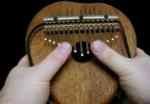 Kalimba:
The Kalimba is also called an African thumb piano. Each of the metal
tines can be plucked individually or in combinations to play chords.
Normally this sort of instrument is tuned diatonically to the key of
C.
Kalimba:
The Kalimba is also called an African thumb piano. Each of the metal
tines can be plucked individually or in combinations to play chords.
Normally this sort of instrument is tuned diatonically to the key of
C.
Mandolin: A standard mandolin has eight
strings that are chromatically fretted. These strings are doubled and
tuned like a violin GDAE from Low to high.
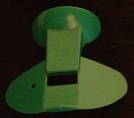 Nose
Flute: The nose flute shown here is a sort of musical toy that
makes one's entire head into a ocarina. The fipple is placed over the
mouth and the blow hole under the nose. The note is controlled by
changing the shape of the mouth cavity while exhaling through the
nose.
Nose
Flute: The nose flute shown here is a sort of musical toy that
makes one's entire head into a ocarina. The fipple is placed over the
mouth and the blow hole under the nose. The note is controlled by
changing the shape of the mouth cavity while exhaling through the
nose.
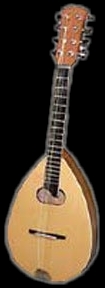 Octave
Mandolin: While a mandolin has the range of a violin, the octave
mandolin has a larger body and longer neck for tuning one octave
lower - like a viola.
Octave
Mandolin: While a mandolin has the range of a violin, the octave
mandolin has a larger body and longer neck for tuning one octave
lower - like a viola.
 Rainstick:
This rainstick is made from some sort of cactus. Others are made from
gourds. When properly dried it produces a sound like rain when it is
upended, allowing the dried contents to pour down inside.
Rainstick:
This rainstick is made from some sort of cactus. Others are made from
gourds. When properly dried it produces a sound like rain when it is
upended, allowing the dried contents to pour down inside.
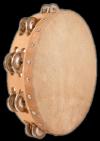 Tambourine:
This is a stretched drumhead with little cymbals set into the frame.
It can be shaken to produce a bright shimmering sound, or it can be
struck to add more depth.
Tambourine:
This is a stretched drumhead with little cymbals set into the frame.
It can be shaken to produce a bright shimmering sound, or it can be
struck to add more depth.
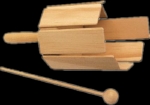 Wood
Block: This is a multi tonal wood block. It's sort of like a
wooden xylophone set in a circle. By striking the different tines
with a mallet, different wood block tones are produced.
Wood
Block: This is a multi tonal wood block. It's sort of like a
wooden xylophone set in a circle. By striking the different tines
with a mallet, different wood block tones are produced.



Clave:
These instruments are basically two hard wood sticks that are clicked
together. They produce a brief sound that is a particularly high note
for percussion.









